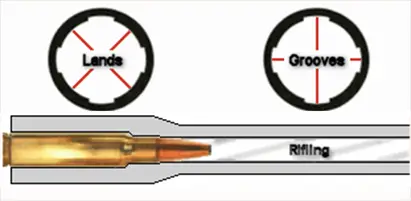
All about rifle barrel twist rate —
Rifled Barrel Terms:
Barrel – The part of the rifle through which projectiles pass in their travel from the chamber or breech to the muzzle.
Bore – The interior of a rifle’s barrel excluding the chamber.
Rifling – Spiral grooves in a gun’s bore that consist of lands (The highest part of the rifling) and grooves (The lowest part of the rifling) which spin the projectile in flight and impart accuracy.
Rifling is present in all true rifles. Rifled bores may be described by the bore diameter which is the diameter across the lands in the rifling, or by groove diameter which is the diameter across the grooves in the rifling.
Rifling Twist Rates:
Expressed in terms of the number of revolutions per inch of barrel length, this ratio is commonly expressed by designations such as 1:10, 1/10 or 1 in 10 twist, the 1 represents 1 twist, the 10 represents inches of barrel length. So, a 1 in 10 twist is, 1 complete bullet revolution every 10 inches of barrel length traveled.
What the rifle barrel twist rate does:
The rate of rifling twist determines the optimum bullet weight for a given caliber and speed of the bullet by applying the proper spin on the bullet to prevent the bullet form yawing and pitching.
How do you know what rifling twist is right:
A good rule of thumb is that the heavier and longer a bullet is, the faster the rifling twist rate needs to be to stabilize it in flight, therefore a lighter shorter bullet needs a slower rifling twist rate to give proper bullet spin for correct flight.
If an insufficient twist rate is used, the bullet will begin to yaw and then tumble; this is usually seen as “keyholing,” where bullets leave elongated holes in the target as they strike at an angle.
Once the bullet starts to yaw, any hope of accuracy is lost as the bullet will begin to veer off in random directions.
A too-high rate of twist can also cause problems. The excessive twist can cause accelerated barrel wear, and in high velocity bullets an excessive twist can cause bullets to literally tear themselves apart under the centrifugal force.
The centrifugal force of a bullet helps to expand the bullet when the bullet impacts a solid object. Velocity and rifling twist rate determine the ballistic centrifugal force of a bullet so barrel length and barrel twist rate together changes the bullet’s centrifugal force, and as a bullet travels downrange the R.P.S. value is constantly decreasing.
R.P.S. = Revolutions Per Second = Centrifugal Force Value.
Note: Higher R.P.S. = More Expansion Of The Bullet.
Choosing the right rifle:
When choosing a rifle cartridge you should always evaluate what you are going to use the rifle for and then select the rifle with the correct rifle barrel twist rate for your particular use by bullet weight to gain the most accuracy.
Measuring the rifling twist rate in a rifle barrel:
To measure the twist of a barrel, use a cleaning rod, magic marker and a tight patch.
- Make a straight line with the magic marker the length of your cleaning rod.
- Start the patch down the barrel, stop and mark the rod at the muzzle and a mark on the muzzle.
- Push in the rod slowly until it has made one revolution, this is verified when the line on the rod lines up with the mark on the muzzle, then make a second mark on the rod at the muzzle.
- The distance between marks on the rod is the rifling twist rate in your barrel.
When you want to learn the ins and outs of long range shooting, we highly recommend this book, available on Amazon.

